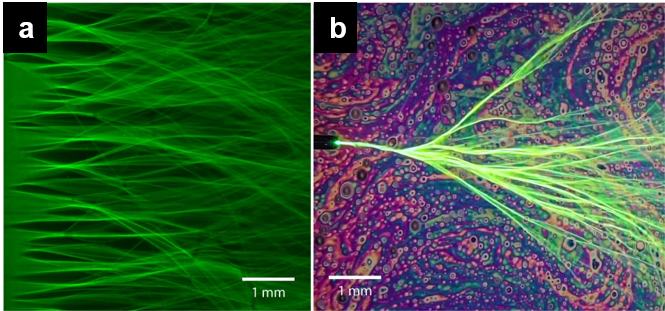Anatoly Patsyk, Uri Sivan, Mordechai Segev and Miguel A. Bandres
Observing Branched Flow of Light
Four prominent Technion scientists recently conducted pioneering research involving the experimental observation of branched flow of light. Their research was published in the prestigious journal Nature. The four physicists are Prof. Uri Sivan, President of Technion; Israel Prize laureate Prof. Mordechai Segev; PhD student Anatoly Patsyk; and postdoc fellow Dr. Miguel A. Bandres.
Branched flow of light refers to a fundamental wave phenomenon that occurs when waves propagate through a weak disordered potential with correlation length larger than the wavelength, thereby forming channels (branches) of enhanced intensity that keep dividing as the waves propagate. It was first observed for electrons and for microwave cavities, and it is generally expected for waves with vastly different wavelengths. For example, branched flow has been suggested as a focusing mechanism for ocean waves including tsunami waves, and was suggested to occur also in sound waves. Branched flow may act as a trigger for the formation of extreme nonlinear events and as a channel through which energy is transmitted in a scattering medium.
The researchers showed that, as light propagates inside a thin soap membrane, smooth thickness variations in the film act as a correlated disordered potential, focusing the light into filaments that display the features of branched flow: scaling of the distance to the first branching point and the probability distribution of the intensity.
“Our scheme, which is essentially a photonic quantum simulator, relies on laser beams propagating inside a thin liquid film – a soap membrane. The soap membrane acts as a two-dimensional waveguide that in our parameter regime supports a single guided mode. The local thickness variations of the membrane led to substantial variations of the effective index of refraction,” the researchers explain.
Despite the random variations in the medium and the linear nature of the effect, they found that the filaments remain collimated (parallel) throughout their paths. Bringing branched flow to the field of optics opens the door to the investigation of a plethora of new ideas such as branched flow in nonlinear media, in curved space or in active systems with gain. Furthermore, the labile nature of soap films leads to a regime in which the branched flow of light interacts and affects the underlying disorder through radiation pressure and gradient force.
for the full article in NATURE magazine

(a) Branched flow of a plane wave. (b) Branched flow of a point source, the colorful background shows the thickness variations of the soap film that drives the branched flow.
From the experiments, we extract the statistical properties of branched flow and other features. Bringing branched flow to optics opens the door to a plethora of new ideas such as branched flow of light in optically-nonlinear media, branched flow of light in curved space, or branched flow of light in systems with gain and loss. The labile nature of soap films and the highly intense branches leads to a new regime where branched flow of light may trigger extreme nonlinear phenomena, or interact and affect the disorder through radiation pressure and the gradient force.
